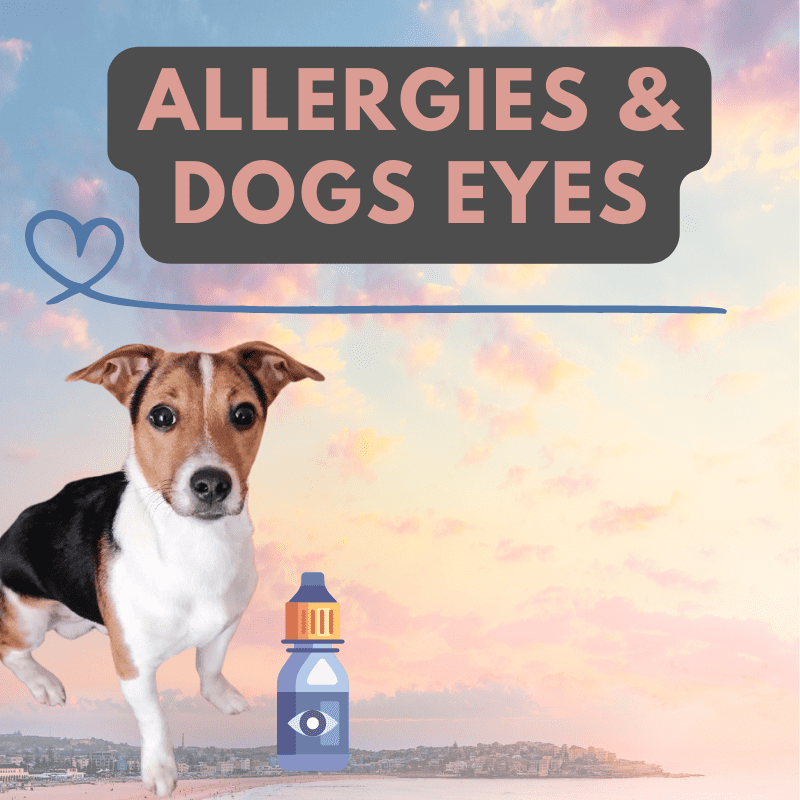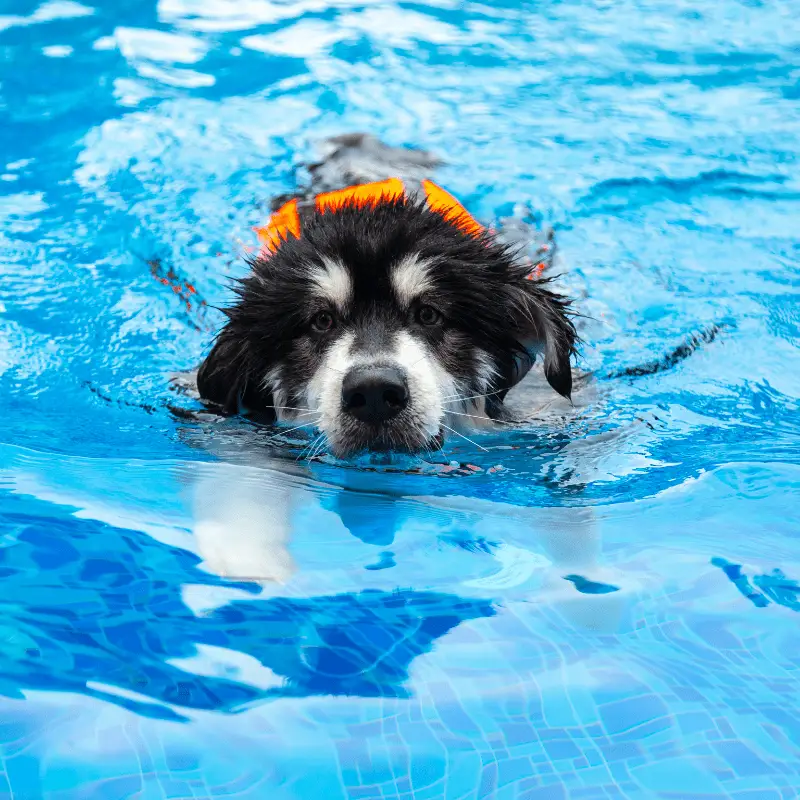Allergies, as you know, affect not only humans but also our dogs. However, attempting to treat one problem at home without professional advice can cause further issues for your dog. That, for one, is human allergy eye drops. Do not use eye drops meant for humans on dogs. These drops have been tested and developed for the human eye, not a dog’s eye. However, the good news is there are dog eye drops out there to treat dog allergies.
Why You Should Not Use Human Drops on Dogs
- It could contain toxic ingredients.
- Can be treating the wrong problem without a proper diagnosis from a vet, which can make the problem worse
Available eye drops for dogs are either unmedicated for more of a soothing approach or medicated, meaning they have healing powers like antibiotics and anti-inflammatory.
The unmedicated dog eye drops work for very mild eye problems. See here my dog with allergies and his journey through his eye issues.
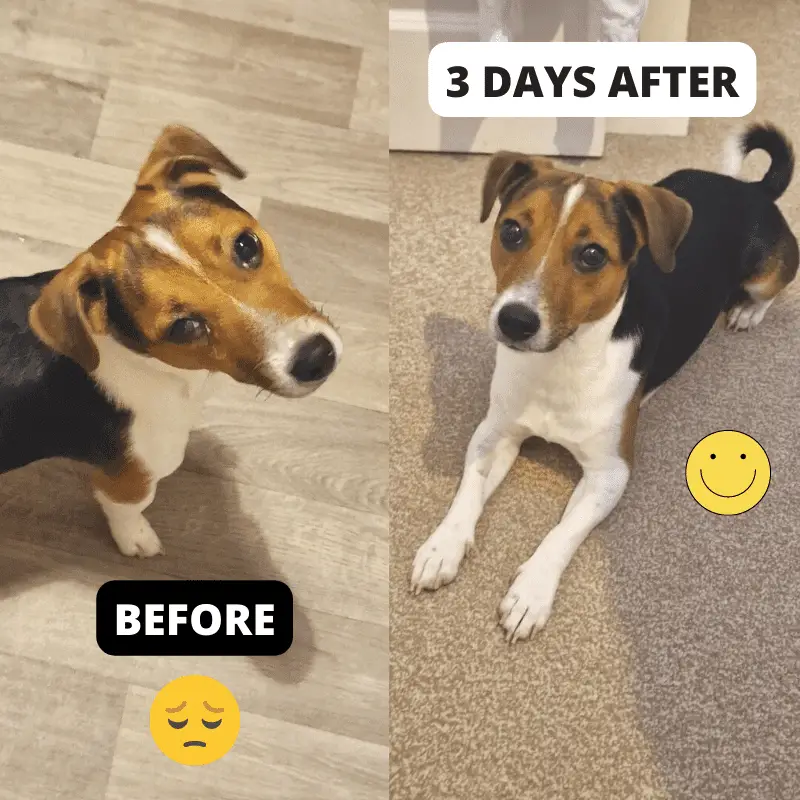
I used unmedicated allergy eye drops for dogs. They’re designed to help relieve the symptoms of irritated, dry and sore eyes in dogs. You can either drop them in if your dog lets you, or you can put a bit on a cotton pad and gently rub the solution over the eye area. Alcohol-free and has no harmful ingredients to dogs.
Eyes are very important and can quickly change; a week later, after getting better, his eyes escalated, so if your dog’s eyes look like this, you must take them to the vet. As unmedicated drops will do nothing for them, your dog will need proper consultation from a professional and will likely be prescribed medicated eye drops.
EYES – allergic conjunctivitis

Symptoms of eye issues in dogs often include:
- Bulging eye
- Cloudy blue eye
- Discharge, green, yellow, clear
- Watery eyes
- Excessive blinking
- Eyelid swelling
- Pawing at the eye
- Redness
- Light sensitivity
- Squinting
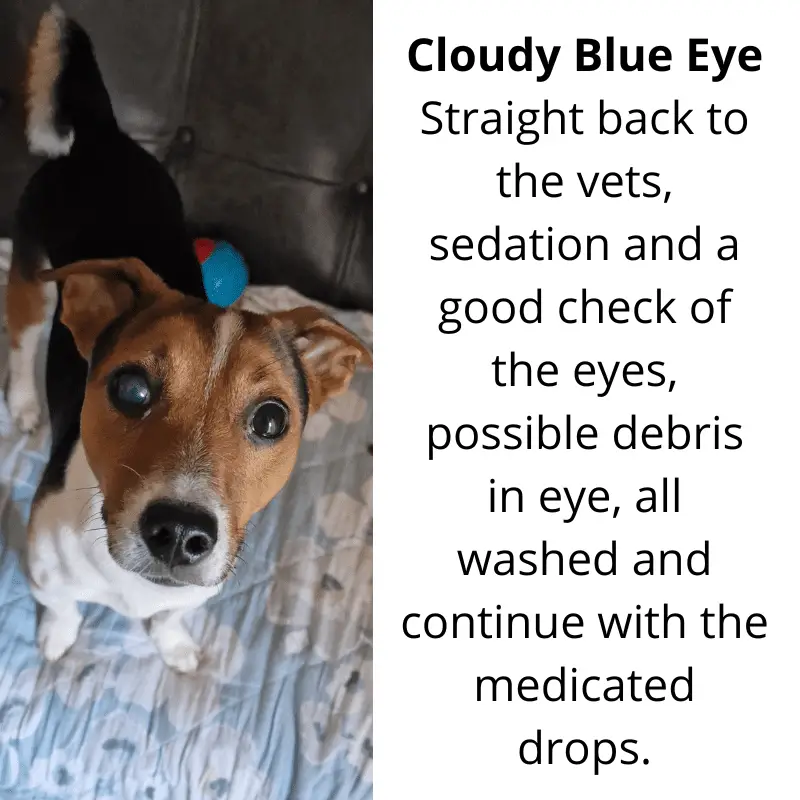
The eyes are a very delicate area for dogs. Not only do they need them to see, but they will also cause a lot of pain and discomfort if left untreated.
It would be best to take your dog to the vet for any symptoms such as bulging eyes, green or yellow discharge, swelling and cloudy blue eyes, or anything that you think needs attention. After all, you know your dog; if their eyes don’t look right, a vet needs to see them immediately.
Pawing at the eye
Another possible onwards issue from allergies is that a dog can paw at the eye area of a mildly irritated eye, thus causing them to scratch the surface. See here my dog’s left eye, which the vet diagnosed as minor scarring from scratching. You can also notice a little blue tinge from scratch pressure build-up.
Pawing at the eye has caused a scratch line, as per the image below, diagnosed by the vet.

Potentially serious common eye issues in dogs
- Conjunctivitis
- Ulcers (usually seen in older dogs)
- Foreign objects getting trapped, such as shrubbery and depbery
- Inverted eyelashes
Medicated Eye Drops For Dogs
Medicated eye drops are given to dogs to treat eye issues and conditions. Such as conjunctivitis, which can only be prescribed by a veterinarian professional and given after consultation or purchased online with a prescription given to you by a vet that you will need to upload to show proof before purchase.
These can include the below eye drops for dogs:
- Chloramphenicol
- Ciprofloxacin
- Clorogen
- Exocin
- Isathal
- Remend
Isathal drops are what I was given for my dog after a trip to the vet. It worked very well. The only issue I had is he didn’t like me putting them in. However, I gave him plenty of boiled chicken treats which helped me administer the drops.

Unmedicated Eye Drops
Unmedicated drops are the perfect solution for any dog with sore, dry or irritated eyes. They can also help clear up foreign surface particles in the eyes and relieve discomfort. However, treatment-wise, these are just eye soothers.
You now understand that you shouldn’t use human eye drops on dogs, and you must use eye drops designed for dogs for the mild irritations that affect your dog’s eyes. Remember that the eyes are essential to your dog. You should always take your dog to a veterinarian professional for any severe or unknown eye conditions to get a proper diagnosis or medicated eye drops. The vet has not only been trained in eye health, but they have seen and treated many dogs with many eye problems, and they will be able to help your dog a lot better than yourself trying to guess and diagnose eye problems at home.
However, one thing that a vet will most likely not suggest to you is to improve your dog’s immune system to handle allergies better through nutrition.
So what you can do instead is help your dog’s immune system so that it can cope with allergen threats through food. It will give your dog the best fighting chance.
First, let’s learn a little about allergies in dogs.
Allergies
Many dogs are affected by allergies because they are constantly exposed to allergens. Allergens can severely affect a dog’s immune system and health.
The immune system will usually function perfectly when the dog is healthy. Occasional harmful allergens, viruses or bacteria entering the body will be met by firm and capable secondary immunity cells and often eradicated quickly.
However, when the immune system deals with such issues as allergies daily, it becomes tired and overworked. If the immune system is tired when it meets these cells that bring severe allergies into the body, it is less likely to be able to cope.
Add to allergies a poor food source with low vitamin and mineral content, and the immune system has a lot to deal with. Therefore, allergies often lead to severe illnesses when dogs are also fed poor-quality food.
Allergy Causes In Dogs That Effect The Eyes:
- Cleaning Products
- Dust
- Mould
- Parasites
- Perfume
- Plants
- Plug-in Air fresheners
- Pollen
- Scented Candles
- Secondhand smoke
How You Can Help A Dog With Allergies Through Nutrition
When a dog has allergies, every day, the dog’s immune system works extra hard to help fight the threat. Whilst working hard on fighting allergies, it can use up all the resources in that area, leaving roles that the immune system also does in jeopardy. Such as cell renewal or fighting severe illnesses like cancer.
So as a dog owner that’s willing to help your dog keep up with the allergy threat and to be able to manage it with a solid, robust immune system, you can and should provide your dog with the very best nutritional foods.
You may think you are already giving your dog the best and healthiest commercial dog food, but you might not.
Firstly check the back of your dog food packet. Ignore the front marketing because every commercial dog food out there is the best formula in the world if we just read the front packaging.
If you find ingredients like bone meal or meat derivatives, big long words that you can hardly pronounce, and the percentage of carbs is high, then the dog food you’re giving your dog isn’t the best and isn’t offering your dog the best nutritional value to fight allergies.
If you have found these ingredients, you have a few things that you can do to improve your dog’s food nutritional intake.
Four Options To Nutritional Improve Your Dogs Food
- Choose a different type of food altogether, such as raw or homemade
- Choose a better quality commercial dog food
- Add fresh food toppers to present food
- Give your dog a good quality multivitamin tablet alongside their food
Change To A Raw Diet For A Food Nutritional Boost
The idea of raw food is that it’s as close to a dog’s natural diet in the wild. Raw food is very nutritional; however, it’s not for everyone’s taste.
Mine and My Dogs Opinions On Raw Food
Even though I am not eating it myself, I found it smelt a bit pondy, and not only that, my dog wasn’t keen on it. Handling raw meat and storing it was a minor concern, ensuring I washed the utensils and hands and that the bowl wouldn’t be left out with any food that could attract flies. However, nutritionally it certainly outweighs my opinions.
He smelt it and walked off. I’m sure he would have eaten it if he were hungry enough.
If you can put up with the smell, you are careful with the raw food, and your dog loves it. It is very nutritional and great for dogs with allergies since it will give them the best quality ingredients and a robust immune system ready to tackle anything!
It’s all about what best works for you and your dog. There is no right or wrong answer when deciding to feed raw food to your dog.
Homemade Food Option For Ulitmate Controlled Nutrition
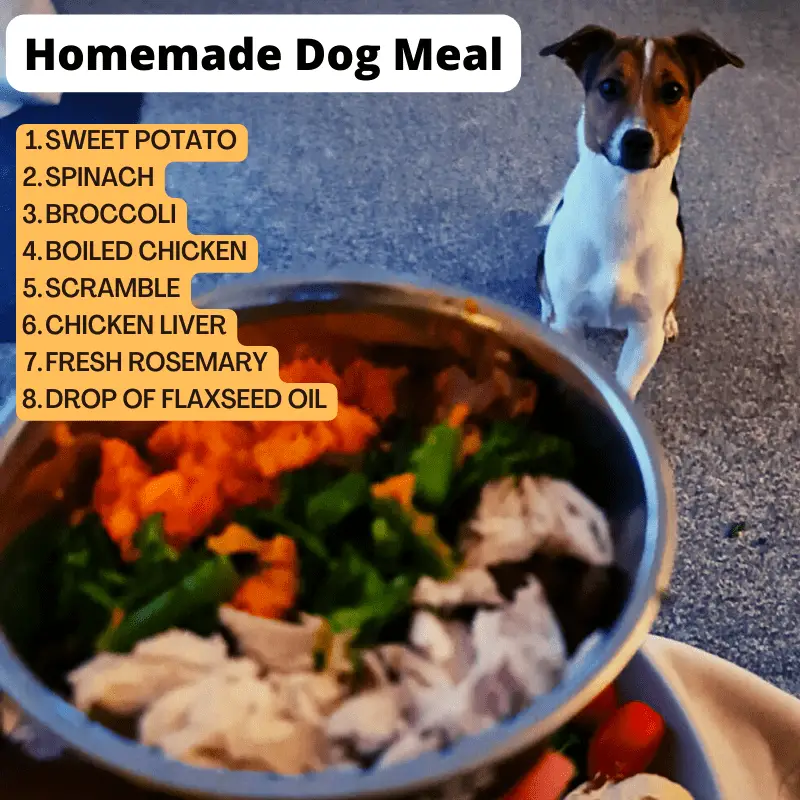
Homemade food is the ultimate nutrition for your dog. It will contain fresh, suitable, no preservatives, chemicals or fillers, only the finest quality ingredients! That you can control.
However, making homemade meals for your dog can be very time-consuming.
It is reasonably simple to do. The best way to do it is to offer your dog an excellent variety of lean meats, organ meats, fruit and vegetables, rice, and oats over a two-week period. Then, your dog should get all the nutritional value that they need.
Be aware that one nutrient often overlooked when dog parents start cooking for their dog at home is calcium. In the wild, dogs would have crunched down on bones daily. So, it is recommended to include a calcium powder sprinkled over the food before serving.
Dogs can also get calcium from eggs, broccoli, kale, and spinach. With all these, a dog can eat safely in the correct portion sizes.
Excellent Healthy Commercial Food Ingredients Found On Back Label To Look Out For
Vegetables: Not derivatives of vegetables. The word vegetable needs to be listed on its own, and are good quality vegetables fit for human consumption, unlike derivatives.
Botanicals, Herbs or Plants: These are added health enhancements for your dog. If listed on the label, the quality is excellent, and your dog’s health is at the forefront of their company.
Pure/Fresh Meat: A highly nutritious and palatable protein source of meat taken from a specific animal. Such as beef, chicken, or duck. The better quality dog foods will have pure or fresh meat labelled.
These are the three most essential ingredients to look for when picking dog food for your dog.
Fresh Dog Food Toppers To Enhance Nutrition
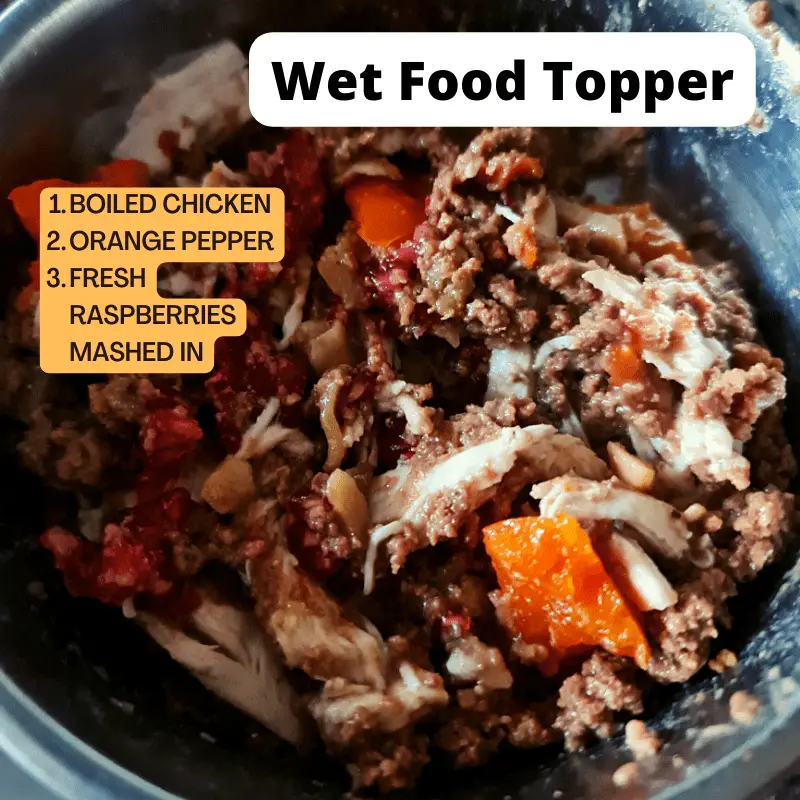
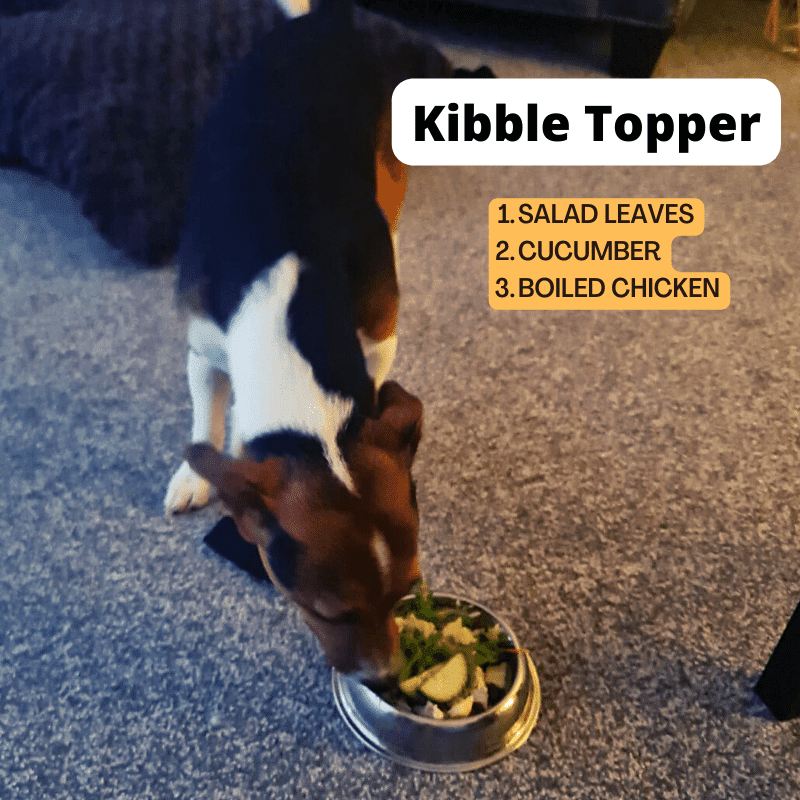
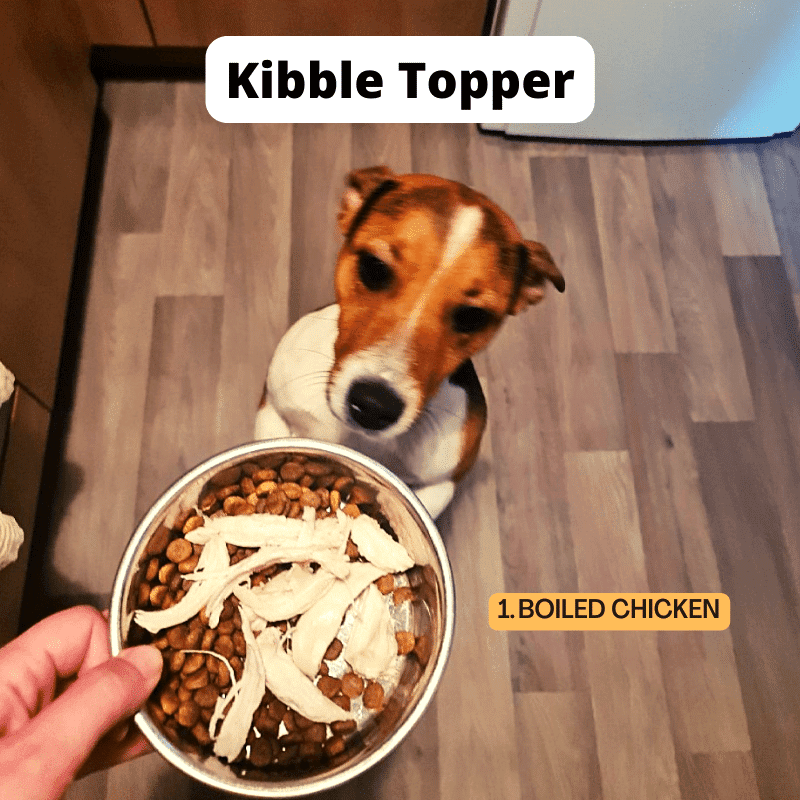
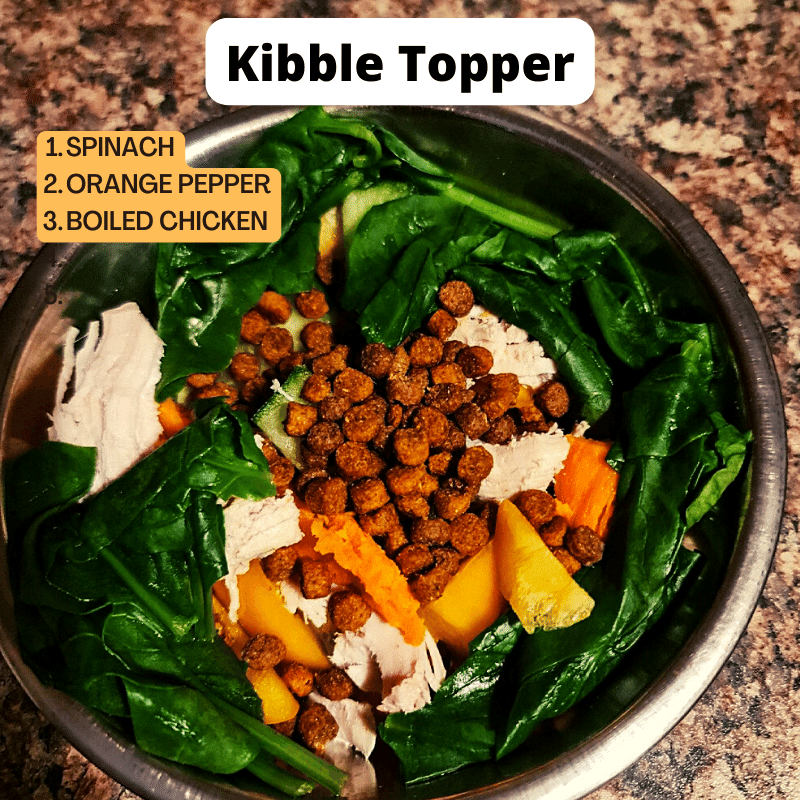
Best Practises When Adding Toppers To Kibble or Wet Food
Try to stay away from carbs when adding topper food items such as pasta, potato, or rice because dogs need fewer carbs, and their food is more than likely loaded with them already.
Dog’s immune systems will benefit instead from carbs from some extra protein, fats, and vitamins like A, C, E or K.
Toxic Foods
When you add any toppers to your dog’s food, ensure that they are plainly cooked and that you haven’t added any seasoning.
Some of the very toxic foods to dogs that we eat can be fatal such as:
- Chives
- Garlic
- Leeks
- Onions
- shallot
- Spring Onions
- Garlic
If you want to know more about these foods, I have written a detailed article explaining what happens to dogs when they eat them, along with prevention and recovery times in case of ingestion.
Artificial Sweetener
Sweetener is a sugar substitute, and its proper name is xylitol. It’s very toxic to a dog so keep your dog well away from any foods or drinks that may contain this. Even chewing gum contains artificial sweeteners, and most foods with low calories or zero sugar usually contain xylitol. Always read the labels and check for them listed.
Wet Food And Dry Food
- Apple without seeds
- Boiled Broccoli
- Boiled carrots
- Cauliflower
- Chopped peppers
- Freshly boiled chicken
- Freshly boiled turkey
- Green Beans
- Pieces of fresh cucumber
- Raspberries
- Sardines in spring water (once a week only)
- Scramble, boiled, or poached eggs
- Spinach raw or boiled
- Watermelon without seeds
- Probiotics: help a healthy digestion
- Goats Milk: for a healthy hydration boost
- Herbs: rosemary, sage, turmeric, parsley
Multi-Vitamins For Dogs To Enhance Their Immune System
Like dog food, even multivitamins can contain nasty ingredients aswell as low-quality ingredients, which are not even worth your dog taking and will not offer any benefit to their health.
When choosing a multivitamin, never pick the cheapest and the most mass-produced manufacturers. Always check the back of the ingredients.
For example, Zesty Paws, as below, my findings of their ingredients added to the Multivitamin Bites. I have broken each component down with an explanation so you can better understand what to look for in a good multivitamin.
Ingredients Explained
- Pea flour: is a good source of essential nutrients like iron, calcium and fibre. These nutrients benefit a dog’s joints, bones and digestive system.
- Chicken: Chicken mainly offers protein, niacin, selenium and phosphorus, all of which a dog needs to function, grow and repair in muscles, cells, hormones, and skin.
- Garbanzo flour: is made of dried chickpeas. Chickpeas have a lot of good things in them, like vitamins A, E, C, folate, magnesium, fibre, potassium and iron. They help out different areas in dogs, like the brain, blood sugar levels, joints and bones, and coat and heart health.
- Pumpkin: Highly nutritious and is rich in vitamin A, which boosts overall immunity, and possibly can improve eye health and skin.
- Natural chicken flavouring: added for better tasting, includes chicken fat and other natural flavours to encourage eating.
- Glucosamine HCL: added to help cushion and lubricate a dog’s joints.
- Flaxseed: a good source of dietary fibre and omega- 3 fatty acids to help with a dog’s digestion and skin and coat health.
- Methylsulfonylmethane: also known as MSM, is added to support joint stress, reduces inflammation, and cares for the overall joints, cartilage and muscles.
- Cod liver oil: is made from the liver of a cod. It contains two essential fatty acids for growth and health: eicosapentaenoic acid and docosahexaenoic acid. These fatty acids help with healthy skin and fur, a strong heart, cell repair and overall physical performance.
- Chondroitin sulfate:
- Vitamin A: vital for the growth of a dog and general well-being
- Coconut glycerin: is safe for dogs, and it has been added to make the vitamin soft and chewy whilst keeping it fresh.
- Ascorbic acid (Vitamin C): Type of Vitamin C. It’s an antioxidant found in fruits and green vegetables. It is essential in maintaining healthy connective tissue, cells, bones, joints and cell repair.
- Dried aspergillus oryzae fermentation extract: helps with fermentation production and is a probiotic to help stop tumour growth.
- Dried aspergillus niger fermentation extract: beneficial fungal to aid good digestion.
- Dried Trichoderma reesei fermentation extract: is a protein production host that produces enzymes.
- Ananas comosus extract: this is the botanical name of a pineapple. Pineapple is rich in vitamin C and has some magnesium and B6. It’s an antioxidant essential in maintaining healthy connective tissue, cells, bones, joints and cell repair.
- Coenzyme Q10: This ingredient is an antioxidant and helps the heart and neurological conditions. However, its also used to treat inflammatory conditions and serious illnesses.
- Sorbic acid (natural preservative): helps stop the spread of mould. It’s non-toxic but needed within multivitamins.
- Lactobacillus acidophilus: is a probiotic which is classed as good bacteria. It helps promote current good bacteria within the dog’s body and helps with the digestive system.
- l plantarum: probiotic that can improve a dog’s liver and digestive system.
- l. brevis: supports the god cells of a dog and helps kill bad cells to fight infections and cancer growths.
- l. fermentum: is a probiotic that helps a dog’s stomach and liver. It also helps to control the levels of cholesterol in the bloodstream.
- l. lactis: a microorganism that plays a role in the fermentation process
- Vitamin D3: is essential for bone and muscle strength and boosts a dog’s immune system.
- D-alpha tocopherol: is a type of vitamin E to maintain healthy skin and coat and to help boost a dog’s natural defences against general illness and infection.
- (Vitamin E) vitamin E to maintain healthy skin and coat and to help boost a dog’s natural defences against general illness and infection.
- (Vitamin B3): The water-soluble vitamin B3, also known as niacin, Supports the digestive system by breaking down fatty acids. It supports a dog’s motor skills and nervous system and helps with hormone production.
- (Vitamin B5): also known as Pantothenic Acid, whose roles are to assist a dog’s body in making and breaking down proteins and fatty acids.
- (Vitamin B6): also known as Pyridoxine, is a water-soluble vitamin that is good for the central nervous system and metabolism. It also helps with cell function.
- (Vitamin B2): also known as Riboflavin, it’s a water-soluble vitamin found in foods like egg yolk, organ meat, and fish. This vitamin is vital for a dog’s metabolism, growth, and development.
- Thiamine: (Vitamin B1) A water-soluble vitamin that helps a dog’s digestive system, is vital for creating a dog’s DNA and supports the growth and functioning of muscles whilst maintaining a healthy weight. It also supports a dog’s motor skills and nervous system.
- Vitamin B12: Encourages a healthy digestive system for dogs. It assists with producing red blood cells and burns fats and carbohydrates for energy. It supports the health of a dog’s nervous system and brain.
- Biotin: also known as Vitamin B7, it’s essential for a dog’s healthy skin, nails, and fur. Biotin also helps process fatty acids and carbohydrates within the dog’s body.
- Folic acid: also known as Vitamin B9, helps with cell generation, oxygen transportation, and overall immune system and controls blood levels of the amino acid.
- Powdered cellulose: Helps to stop the food from clumping; good at absorbing water. No nutritional value but serves the purpose of formation of the multivitamin.
- Rosemary extract: gives the multivitamin a sweet smell to encourage eating. It also is a natural antioxidant and helps preserve the multivitamin.
- Mixed tocopherols: part of the vitamin E group, its primary role is to slow down the spoiling process of the multivitamin.
The company “Zesty Paws” started in 2014 and is partnered with high-quality brands for individual ingredients. They are very transparent on their website, make a point, and seem proud of their premium ingredients.
The price of this multivitamin is higher than most, which indicates it has better quality ingredients.
Body Weight and Amount Per Day
- Small Dogs: Up to 25lbs = 1 Soft Chew Per Day
- Medium Sized Dogs: 26lbs – 75lbs = 2 Soft Chews Per Day
- Large Dogs: Over 75lbs = 3 Soft Chews Per Day
Human Hay Fever Tablets
Giving your dog an allergy tablet meant for humans for the first time is a bad idea. If you don’t know what they are allergic to or if the problem is related to allergies, it can cause more harm than good. It’s best not to take any chances by giving human medication without first getting consent from someone who does understand these things, like a vet.
Final Words
My advice is never to leave the eyes of a dog. Always take them to the veterinarian. My dog certainly had a lot going on with his eyes, the quick healing then leading to more issues like conjunctivitis, allergies, a cloudy blue eye, and even scratching the eye and causing damage.
This image was taken this morning, and his eyes are back to normal. Allergy-free eyes!

Good luck, and remember the importance of eye health in dogs!

